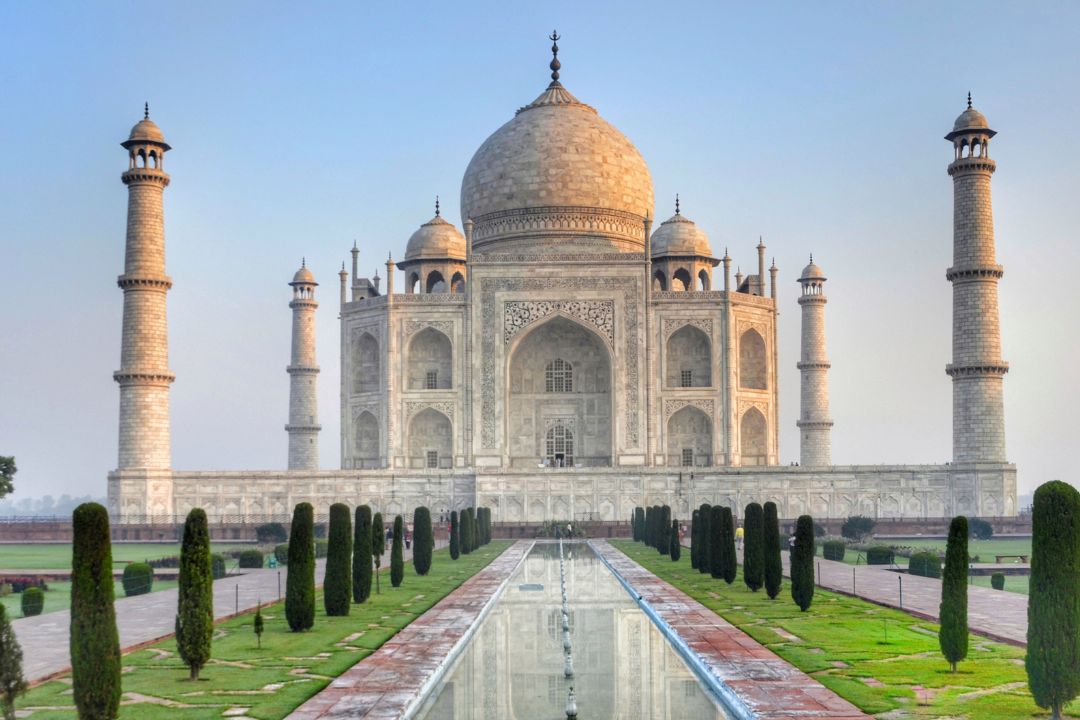The Hidden Symbolism in the Taj Mahal’s Design

Overview of Hidden Symbolism
One of the most famous buildings in the world, the Taj Mahal, is well-known for its elaborate design and rich Hidden Symbolism in addition to its stunning beauty. The Taj Mahal, the height of Mughal architecture, was commissioned by Mughal Emperor Shah Jahan as a memorial to his beloved wife Mumtaz Mahal. It carries profound cultural and spiritual significance. We look at a few of the buried meanings in its layout below.
1. The Gardens: An Allegory of Heaven
A prominent feature of Mughal architecture, the charbagh, or quadrilateral garden, Hidden Symbolism surrounds the Taj Mahal. The walkways and water channels that divide this garden into four sections represent the four rivers of paradise that are mentioned in Islamic texts. The design embodies the idea of paradise in Islam, a perfect garden symbolic of the celestial home where the faithful are expected to dwell after death.
2. The White Marble: Completeness and Objectivity
White marble was used in the Taj Mahal’s construction as a symbol of perfection and purity. Throughout the day, the marble’s luminescent quality shifts, reflecting various colors and symbolizing the fleeting nature of beauty and life. The material selection is meant to arouse feelings of peace and spiritual elevation, in keeping with the structure’s embodiment of the theme of eternal love.
3. The Central Dome: Establishing a Divine Connection
Rising to a height of roughly 35 meters, the Taj Mahal’s central dome is meant to symbolize the vault of heaven. Its profound architectural significance stems from its symbolic representation of the relationship between the divine and the earthly realm. Four smaller domes flank the main dome, adding to its grandeur and symbolizing the divine’s presence in the world below.
4. The Minarets: The Tomb’s Keepers
In addition to being distinctive architectural elements, the four minarets that encircle the Taj Mahal have profound symbolic significance. These towers, which are about 40 meters tall, are angled slightly outward to prevent them from falling on the tomb in the event of an earthquake. In a symbolic sense, they guard the mausoleum, preserving it and amplifying its architectural impact. Their height is symbolic of reaching up toward the sky.
5. Calligraphy and Inscriptions: A Spiritual Message
Quranic verses are adorned in elaborate calligraphy at the Taj Mahal’s entrance. The meanings of these inscriptions are love, faith, and the fleeting nature of existence. The words chosen deepen the monument’s emotional impact by reinforcing the idea of eternal love and serving as a reminder of the divine bond between Mumtaz Mahal and Shah Jahan.
6. The Water Pool: Duality and Reflection
The Taj Mahal’s reflection in the water signifies both the earthly and spiritual realms, and the long reflecting pool in front of the monument stands for the duality of existence. Visitors are encouraged to pause and take in the beauty of the building and its surrounds as a result of this interaction, which produces a sense of harmony and balance. The serene waters also symbolize the serenity connected to Mumtaz Mahal and Shah Jahan’s enduring love.
7. Symmetry: Equilibrium and Harmony
Symmetry and balance are essential ideas in Islamic art and architecture, and they form the foundation of the Taj Mahal’s whole design. In addition to improving the structure’s aesthetic appeal, this meticulous balancing represents harmony in both the cosmos and in life. Every aspect of the Taj Mahal, from the arrangement of the tomb and surrounding structures to the design of the gardens, all work together to create a unified and beautiful visual experience.
In summary
Beyond its stunning architecture, the Taj Mahal is a work of art that represents love, spirituality, and the pursuit of perfection. Deep Hidden Symbolism permeates every aspect of its design, which reflects the era’s cultural and religious ideals. While taking in its majesty, visitors discover a complex web of symbolic meanings that enhance their experience of one of the most well-known monuments in the entire world. In addition to serving as a reminder of a ruler’s devotion to his spouse, the Taj Mahal is a timeless representation of the universal themes of love, grief, and the prospect Hidden Symbolism of eternal life.
